A.2 Infrared (IR)
IR is another technology that's seen better days, but once again, its replacements are still struggling to standardize. Consequently, you may find it worth your time and effort to make IR work on your Mac.
As mentioned in Chapter 1, IR is also referred to as IrDA, short for Infrared Data Association. IrDA is the name for both the body that creates IR standards as well as the protocol they've created.
IR is quite possibly the most popular form of wireless technology on earth, simply because it's used in so many places other than computers: it's the technology that's used by most remote controls, so it's included in almost everything in your home theater setup. A short time ago, we replaced an air conditioner in our office, and the new unit came with an IR remote control. And, as you already know from having to point your remote at your TV set in order to change the station, IrDA involves short-range line-of-sight connections between two devices.
However, Apple's made it pretty darn clear that IR is the past, and Bluetooth is the future. If you're considering buying a phone or Palm device with IR support, we strongly recommend that you consider one with Bluetooth instead (or in addition). IR in Mac OS X has considerably fewer capabilities than it did under OS 9 (such as file transfers), and it's not likely that Apple will offer much in the way of future support. After all, they haven't introduced an IrDA-equipped Mac in almost two years.
If you have a Mac that was introduced after January 2002, you don't currently have IrDA. If you have an older Mac, the "Apple and IR: a Brief History" sidebar and Table A-1 will tell you if your Mac currently has an IR port. You can also tell by looking for an IR port; Figure A-3 shows its location on a PowerBook G4.
|
Macintosh model |
IRTalk |
IrDA |
|---|---|---|
|
PB 190 |
Yes |
No |
|
PB 5300 |
Yes |
No |
|
PB 1400 |
Yes |
No |
|
PB 3400 |
Yes |
Yes |
|
PB 2400 |
Yes |
Yes |
|
PB G3 (early) |
Yes |
Yes |
|
PB G3 (later) |
No |
Yes |
|
PB G4 (through Gigabit Ethernet) |
No |
Yes |
|
iMac (Rev. A and B only) |
No |
Yes |
Figure A-3. The IR port (circled) on a PowerBook G4 (Gigabit Ethernet)
Apple and IR: A Brief HistoryApple has shipped a variety of Macs with number of different infrared receivers, starting with the Mac TV in 1993. Unfortunately, this machine (along with a few others) only used IR for input, so the included remote control could send commands to the Mac's internal TV tuner. Starting with the PowerBook 190, Apple started to include IR on its laptops as an early way to share files if you didn't happen to have network cables on hand. These machines (which also included the PowerBook 5300 and PowerBook 1400) were not IrDA-compliant?instead, they used an Apple-proprietary technology called IRTalk, which was used to transport AppleTalk via IR. These were the first Macs with bi-directional IR, although IRTalk has data throughput speed of only 230 Kbps. In effect, IRTalk was a wireless replacement for an AppleTalk or serial cable between machines. In 1997, with the PowerBook 3400, Apple made the decision to support both IRTalk and IrDA, as the latter can handle AppleTalk and TCP/IP as well as connecting to external devices at up to 4 Mbps. Consequently, the 3400, 2400, and early G3 models are the only laptops that can use IR to communicate with both early and later IR-equipped machines. In 1998, Apple shipped their only IrDA-compatible desktop machine and their first IR-capable machine to not support IRTalk: the Revision A and B Bondi Blue iMacs. IR on the desktop was discontinued in 1999 with the fruit-colored (revision C) iMacs. The PowerBook G3 Series (Bronze Keyboard) shipped in 1999, and was the first IR-equipped PowerBook to not support IRTalk. All PowerBooks from this one up until the PowerBook G4 (Gigabit Ethernet) in 2001 came with IrDA-only capability. No iBook has come with IR. The PowerBook G4 (Gigabit Ethernet) was the last Mac to include IR, and Macintoshes introduced in 2002 and later do not ship with IR. Table A-1 shows which Macs support which protocol. |
Don't have IrDA on your Mac? If you find that you need it, don't give up yet?as long as you have USB, you can use MadsonLine's (http://www.madsonline.com/) $58 USB-IrDA Adapter (seen in Figure A-4). Just plug it in, and you've got an IR-equipped Mac. In fact, because IR is so picky about line-of-sight and distance issues, it can be easier to use the MadsonLine adapter, because it attaches to your Mac via a USB cable?so you can point it in any direction you want.
Figure A-4. MadsonLine's USB-IrDA Adapter

|
Hooking the adapter up is as easy as plugging in a USB cable. Once you do that, go into your Network Control panel, and you'll see a message like the one in Figure A-5.
Figure A-5. Mac OS X has recognized a new device; in this case, the IrDA adapter
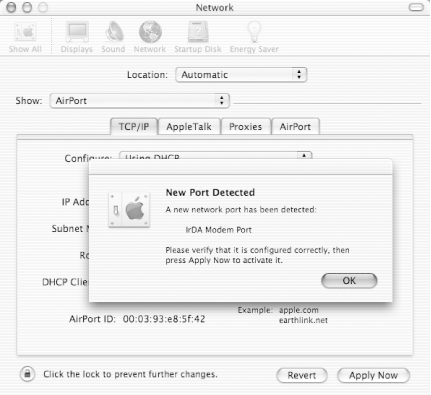
A.2.1 Configuring IrDA
Whether your Mac came with IR installed, or whether you added it via an adapter, it needs to be set up to use it. Start off by going into the Network Control Panel. To modify the IrDA Modem Port preferences, show the Network Port Configurations Pane and click the "On" button next to "IrDA Modem Port," as shown in Figure A-6.
Figure A-6. The IrDA Modem Port needs to be turned on in order to configure it
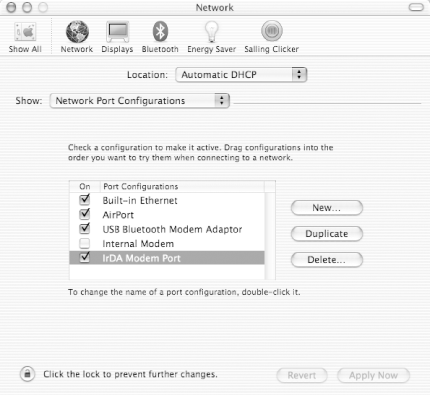
Figure A-7 shows the IrDA Modem Port Pane and the IrDA Modem tab. IrDA devices can be used as a modem in a similar fashion to the way Bluetooth devices can be used as a modem, as described in Chapter 7.
Figure A-7. The IrDA Modem Port pane
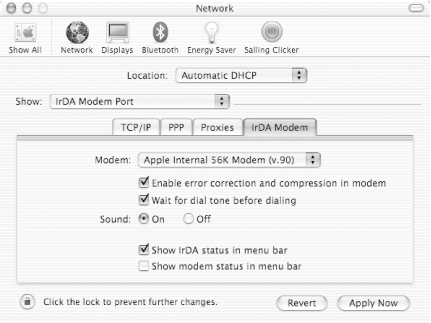
If you click the "Show IrDA status in menu bar" check box, the current status of the IR port will be displayed. Depending on the current status, different icons are shown, as in Figure A-8.
Figure A-8. The five faces of IrDA: discovering, idle, off, connected, and broken beam
The first icon is "Discovering" and the second is "Idle." So long as IrDA is on and no IrDA-compatible devices are found within range, your Mac will constantly cycle between these two icons. If IrDA is turned off, the third icon will display. The fourth icon, "Connected," will display when an IrDA device is found. The last icon, "Broken Beam," will display if you've been connected, but the connection has been interrupted.
If you take a look at the IrDA pull down menu while you're connected, you'll see a menu like the one in Figure A-9. The first line tells you information about your connection, the second allows you to turn IrDA off, and the third lets you control whether or not you want sounds to be played when a device is found.
Figure A-9. A successful IrDA connection
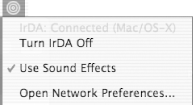
A.2.2 IR and Palm Devices
Before Bluetooth was added to Palm devices, there was IR, and Palm still sells many devices that don't have Bluetooth. No, you don't always have to lug around cables and docks?you can use IrDA to sync the two. Syncing your Palm using the IR port on your Mac is almost identical to that of using Bluetooth, as described in Chapter 6. Consequently, we'll only cover the differences here.
Turn off the IrDA Modem Port off, as shown back in Figure A-6. The IR port can only be used for one purpose at a time.
Make sure that the IR port is turned on in HotSync Software Setup
Conduit Settings, as shown in Figure A-10.
Figure A-10. Turning on the IR port
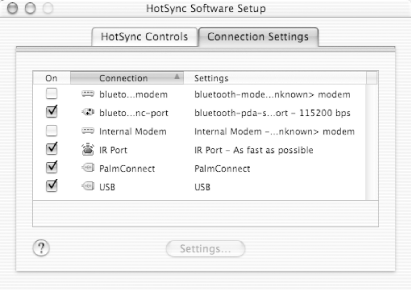
On the Palm, change the connection type to "IR to a PC/Handheld," and make sure you've chosen a "Local" connection.
Make sure that the IR port on the Palm and the IR port on the Mac are facing each other, and are less than three feet away.
Tap the HotSync button on the Palm, and syncing should begin.
Have patience, as syncing via IR can be very slow.
A.2.3 Other IR Devices
There are a number of other IR devices of varying usefulness, but overall, they're becoming less common as Mac OS X becomes more popular. The accessories don't make the transition?for instance, when was the last time you used a Newton? IR-enabled printers, for example, are being phased out as Wi-Fi and Bluetooth-capable printers are being introduced.
One handy device we've found, though, is the Keyspan Digital Media Remote, (Figure A-11) particularly if you don't have the capability to run Salling Clicker, which uses Bluetooth.
Figure A-11. The Keyspan Digital Media Remote and receiver
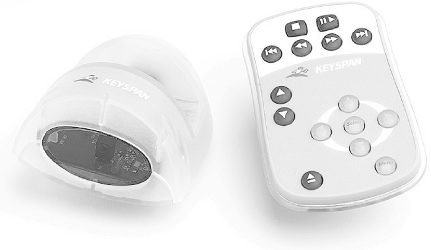
This device comes with its own IR receiver, which works (or so Keyspan claims) up to 35 feet away from the remote. You do have to be in line-of-sight, but from our experience, it's fairly forgiving. It can control everything from PowerPoint to Keynote to iTunes to DVD Player. Installation is simple; just plug it in and install drivers.
|
Infrared is likely to be the last technology you'll have to deal with that will require both devices to be within line-of-sight of each other. Thankfully, its short distance and location requirements have combined to make it trailing-edge technology.








